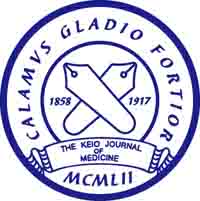[Advanced Published online The Keio Journal of Medicine, by J-STAGE]
<Title:> Regulatory T Cells: Pathophysiological Roles and Clinical Applications
<Author(s):> Ryota Sakai, Kyoko Komai, Mana Iizuka-koga, Akihiko Yoshimura, Minako Ito
<Corresponding author E-Mill:> ito(at)a3.keio.jp
<Abstract:> Inflammation and immune responses after tissue injury play pivotal roles in the resolution of inflammation, tissue recovery, fibrosis, and remodeling. Regulatory T cells (Tregs) are responsible for immune tolerance and are usually activated in secondary lymphatic tissues. Activated Tregs subsequently regulate effector T cell and dendritic cell activation. For clinical applications such as the suppression of both autoimmune diseases and the rejection of transplanted organs, methods to generate stabilized antigen-specific Tregs are required. For this purpose, transcriptional and epigenetic regulation of Foxp3 expression has been investigated. In addition to conventional Tregs, there are some Tregs that reside in tissues and are called tissue Tregs. Tissue Tregs exhibit tissue-specific functions that contribute to the maintenance of tissue homeostasis and repair. Such tissue Tregs could also be useful for Treg-based cell therapy. We recently discovered brain Tregs that accumulate in the brain during the chronic phase of ischemic brain injury. Brain Tregs resemble other tissue Tregs, but are unique in expressing neural cell-specific genes such as the serotonin receptor (Htr7); consequently, brain Tregs respond to serotonin. Here, we describe our experiences in the use of Tregs to suppress graft-versus-host disease and to promote neural recovery after stroke.
<Keywords:> regulatory T cell, epigenetics, GVHD, stroke, tissue repair
<URL:> https://www.jstage.jst.go.jp/article/kjm/advpub/0/advpub_2019-0003-OA/_html


![Reoperative Aortic Valve Replacement for Structural Valve Deterioration through a Lower Hemisternotomy after a Previous Bentall Procedure in a Patient with Tracheostomy [Published online Keio J Med, 72, 21-25, by J-STAGE]](http://kjm.pupu.jp/blog/wp-content/uploads/2023/03/2022-0009-CR-100x100.jpg)
![Dementia care and research – What a difference a decade makes? [Published online Keio J Med, 68, 68-68, by J-STAGE]](http://kjm.pupu.jp/blog/wp-content/uploads/2019/09/68-004-ABST-100x100.jpg)
![Serum Neurogranin Measurement as a Biomarker of Central Nervous System Infections: A Preliminary Study [Published online in advanced , by J-STAGE]](http://kjm.pupu.jp/blog/wp-content/uploads/2022/06/2021-0019-OA-100x100.jpg)
![Concerns Associated with Uterus Transplantation in Japan [Published online Keio J Med, 70, 68-71, by J-STAGE]](http://kjm.pupu.jp/blog/wp-content/uploads/2021/09/KJM_logo-100x100.jpg)
![Percutaneous Tendon Needling without Ultrasonography for Lateral Epicondylitis [Published online Keio J Med, 69, 37-42, by J-STAGE]](http://kjm.pupu.jp/blog/wp-content/uploads/2020/06/2019-0004-OA-100x100.jpg)
![Paradigm Shifts in Nutrition Therapy for Type 2 Diabetes [Published online Keio J Med, 66, 33-43, by J-STAGE]](http://kjm.pupu.jp/blog/wp-content/uploads/2017/09/2016-0016-IR-100x100.jpg)
![The History and Future of Unlinked Total Elbow Arthroplasty [Published online in advanced , by J-STAGE]](http://kjm.pupu.jp/blog/wp-content/uploads/2017/08/2017-0007-IR-100x100.jpg)
![Roles of Hypoxia Response in Retinal Development and Pathophysiology [Published online Keio J Med, 67, 1-9, by J-STAGE]](http://kjm.pupu.jp/blog/wp-content/uploads/2018/03/2017-0002-IR-100x100.jpg)
![Dr. Seiji Ogawa and the Past, Present, and Future of Functional MRI Research [Published online Keio J Med, 68, 71-72, by J-STAGE]](http://kjm.pupu.jp/blog/wp-content/uploads/2019/12/68-4_Editorial-100x100.jpg)
![Virus and Host Events in Squamous Carcinogenesis [Published online Keio J Med, 65, 78-78, by J-STAGE]](http://kjm.pupu.jp/blog/wp-content/uploads/2016/12/65-004-ABST-100x100.jpg)